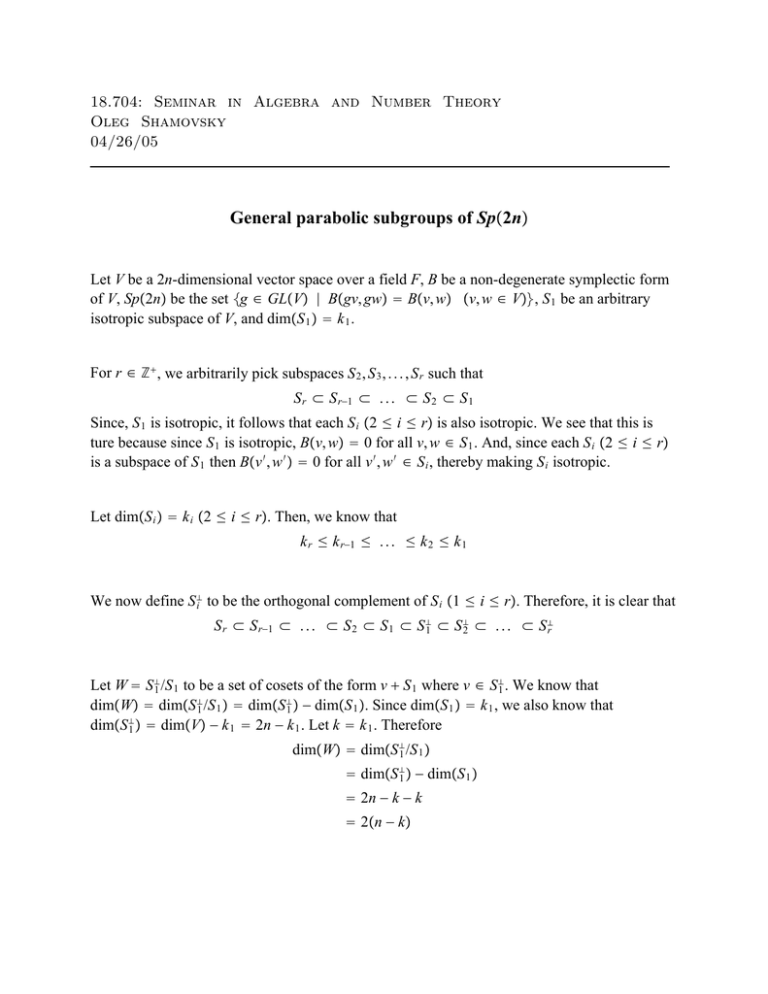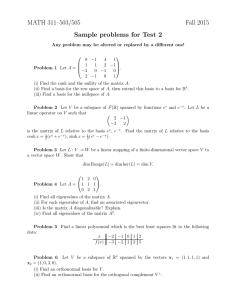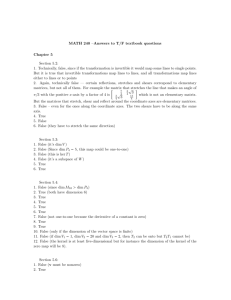Sp n
advertisement

18.704: Seminar in Algebra and Number Theory Oleg Shamovsky 04/26/05 General parabolic subgroups of Sp2n Let V be a 2n-dimensional vector space over a field F, B be a non-degenerate symplectic form of V, Sp2n be the set g ∈ GLV ∣ Bgv, gw Bv, w v, w ∈ V, S 1 be an arbitrary isotropic subspace of V, and dimS 1 k 1 . For r ∈ ℤ , we arbitrarily pick subspaces S 2 , S 3 , . . . , S r such that S r ⊂ S r−1 ⊂ . . . ⊂ S 2 ⊂ S 1 Since, S 1 is isotropic, it follows that each S i 2 ≤ i ≤ r is also isotropic. We see that this is ture because since S 1 is isotropic, Bv, w 0 for all v, w ∈ S 1 . And, since each S i 2 ≤ i ≤ r is a subspace of S 1 then Bv ′ , w ′ 0 for all v ′ , w ′ ∈ S i , thereby making S i isotropic. Let dimS i k i 2 ≤ i ≤ r. Then, we know that k r ≤ k r−1 ≤ . . . ≤ k 2 ≤ k 1 We now define S i to be the orthogonal complement of S i 1 ≤ i ≤ r. Therefore, it is clear that S r ⊂ S r−1 ⊂ . . . ⊂ S 2 ⊂ S 1 ⊂ S 1 ⊂ S 2 ⊂ . . . ⊂ S r Let W S 1 /S 1 to be a set of cosets of the form v S 1 where v ∈ S 1 . We know that dimW dimS 1 /S 1 dimS 1 − dimS 1 . Since dimS 1 k 1 , we also know that dimS 1 dimV − k 1 2n − k 1 . Let k k 1 . Therefore dimW dimS 1 /S 1 dimS 1 − dimS 1 2n − k − k 2n − k A stabilizer P for S r ⊂ S r−1 ⊂ . . . ⊂ S 2 ⊂ S 1 is defined as PS r ⊂ . . . ⊂ S 1 g ∈ SpV ∣ gS r S r , . . . , gS 1 S 1 To give a homomorphism f from a group P to a direct product group G r G r−1 . . . G 1 G 0 is the same as giving r 1 separate homomorphisms f i : P G i where i 0, 1, . . . , r. The relationship is: fp f r p, f r−1 p, . . . , f 0 p G r . . . G 0 We now define the following group homomorphism: f : PS r ⊂ . . . ⊂ S 1 GLS r GLS r−1 /S r . . . GLS 1 /S 2 SpW as a coordinate homomorphism: If g ∈ P, then f r g g| S r ∈ GLS r f r−1 g g| S r−1 /S r ∈ GLS r−1 /S r f 1 g g| S 1 /S 2 ∈ GLS 1 /S 2 f 0 g g| S 1 /S 1 ∈ SpS 1 /S 1 Note that we use the notation g| A to mean the restriction of g to the subspace A. Let N f be the kernel of f. We know that the kernel of a group homomorphism is a normal subgroup. Thus, N f is a normal subgroup of PS r ⊂ . . . ⊂ S 1 . Let N be a normal subgroup of S r ⊂ . . . ⊂ S 1 (denoted NS r ⊂ . . . ⊂ S 1 ) which is defined as: g ∈ SpV such that gx r x r x r ∈ S r , gx r−1 x r−1 an element of S r x r−1 ∈ S r−1 , gx 1 x 1 an element of S 2 x 1 ∈ S 1 gw w an element of S 1 w ∈ S 1 With the help of the class, I outlined some examples in lecture showing that the above definition defines a normal subgroup of PS r ⊂ . . . ⊂ S 1 . Furthermore, from the definition of f and N f above, we see that N f NS r ⊂ . . . ⊂ S 1 . It then follows that f defines an inclusion: PS r ⊂ . . . ⊂ S 1 /NS r ⊂ . . . ⊂ S 1 GLS r GLS r−1 /S r . . . GLS 1 /S 2 SpW which is also surjective. Note: the proof of surjectivity is left out of these notes; it involves finding a number of elements of P and showing that every element of GLS r GLS r−1 /S r . . . GLS 1 /S 2 SpW is an image (under f) of elements of P/N. Therefore, f is a bijective map from PS r ⊂ . . . ⊂ S 1 /NS r ⊂ . . . ⊂ S 1 to GLS r GLS r−1 /S r . . . GLS 1 /S 2 SpW, which implies that PS r ⊂ . . . ⊂ S 1 /NS r ⊂ . . . ⊂ S 1 ≅ GLS r GLS r−1 /S r . . . GLS 1 /S 2 SpW Note the difference between this result and the one demonstrated for maximal parabolic subgroups of Sp2n in a previous talk. Specifically, for maximal parabolic subgroups: PS/N GLk, F SW whereas for general parabolic subgroups, we have PS r ⊂ . . . ⊂ S 1 /NS r ⊂ . . . ⊂ S 1 ≅ GLS r GLS r−1 /S r . . . GLS 1 /S 2 SpW








